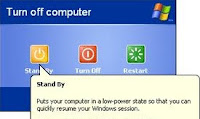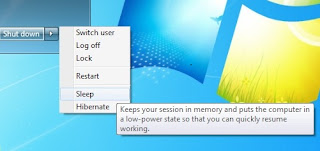Sleep/Standby - An alternative to shutdown
 |
| Windows XP |
 |
| Windows 7 |
|
- The system is in low power state (processor and RAM are in low clock mode).
- Most peripheral devices are turned off.
- Power consumption of the entire system is negligible, but not 0.
- All data is lost if the power source is disconnected.
- Advantages:
- Fast - Standby and resume are really quick < 2 secs.
- The system state is preserved on resume - looks just the way you left it.
- Saves power - very little power consumption.
- Disadvantages:
- System still consumes little power.
- All data is lost if the power source is disconnected.
- How to standby: Any one of the following:
- Press the "Sleep" key on your keyboard.
- Select "Sleep/Standby" option from the shutdown menu. (You can also Press "s" when in the shutdown menu)
- Configure Power options.
- How to resume: Depending on your system:
- Press any key.
- Press the wake-up key.
- Press the power button lightly.
- When to use: When you go on a short break..
- When not to use:
- When you go on a long break ( > 30 minutes). It's better to hibernate.
- If there are chances of a power failure.
Note:
- Take care not to disconnect the power source. A laptop's batter will drain at a lower rate.
- Windows 7 has a feature called "Hybrid sleep" which is a combination of sleep and hibernate.


No comments:
Post a Comment